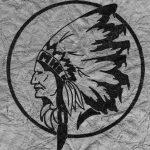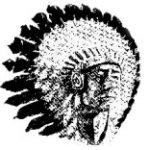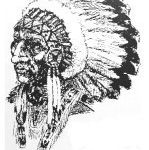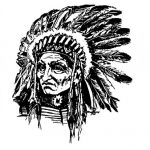
Through the early years of MHS, it appears there was no unified school rallying name, no mascot. The sports teams were known either as Jr Wildcats or simply ‘The Blues’. The first Pep Club, formed in 1931, called themselves the Blue Dragons. “The Commentator,” a columnist in The Manhattan Mentor (as the school paper was then known) wrote in the Oct 6th, 1939 issue, “The Pep Club lacks pep.” The writer asked for a club whose members joined for more than social reasons and whose spirit would spread to the whole student body. To further this end, the unnamed Commentator proposed that the school adopt a new name; the schools sport teams should not be taken lightly, as in “Juniors,” and “Blues was just plain weak…probably just some reporter’s abbreviation of the former name of Blue Dragons.” (More research is needed to be clear about this former name which now seemed only to apply to the Pep Club.)

How to increase school spirit became the charge and a better name for the sports teams seemed one good remedy. In December the basketball team opened the season as the Jr Wildcats with spiffy new uniforms of deep blue with red numerals and horizontal red and white strips on the shorts. Then in January, the M Club sponsored the selection of a new name. Fifteen possibilities were contributed by the students. From suggestions like Blue Devils, Bob Cats, Falcons, Blue Eagles, Buccaneers, Pirates, Hornets, Wolverines and Indians, the lettermen chose four finalists; the entire student body voted. By March 15, 1940, the MHS teams had become the “Indians.”
Line drawings of a Chief and an Indian woman (Figure 1) graced the 1940 Blue M title page. Indian images immediately appeared in places that will be familiar to many MHSers: on the backs of the cheerleaders’ uniforms, caricatures in The Mentor and the Blue M, in the center of the bass drum. The 1941 Blue M had an Indian in red outlined on a royal blue cover (Fig 2). The MHS Football coach, Frank Prentup, was of Native American ancestry, and he is believed to have donated the first Indian headdress to the school. Ralph Rogers, retired teacher/ Administrator at MHS, said in an interview for The Mentor in 1992 that the selection of the Indian as the mascot was to honor Prentup.



By the time the MHS West Campus was built in 1957, the Indian on the front of Student Handbooks had grown in sophistication (Figure 3.) Many MHS alums of those days remember the official school colors of blue and white used without the red accent. A headdress was worn when the Drum Major and twirlers for the Marching Band decided on new Indian themed uniforms for their new school, new season. The band’s popular War Chant had become a fixture at athletic events.
The Indian mosaic was installed in the floor at the entrance to the gym of the new MHS building and the tradition of “Don’t Tread on Me” was begun. In the scheme of things, it was not to last long.

With the political and racial tumult of the late 60s, things took on a more intense flavor even at MHS. The mosaic Indian got a cordon to protect him from unwanted touches, a metal fence with spiky stanchions to guard him from rowdies – both theirs and ours. The Mentor (which had by then lost the “Manhattan” part of its earlier name) reported in 1972 that “traditionally the Indian (mosaic) has stood for a scene of initiation for the sophomores by the upper classes,” where the lowly ones were pushed onto it, made to shine it. But the first day of school in ‘72 found 1300 kids rushing an unprotected Icon: the fence had been removed during the summer because it was deemed an impending fire hazard. (Not to mention the danger of ripping clothing and bodies of students tossed across it.)
At games, strident cries like “Scalp the Indians” from opposing fans began to sound ugly and as early as 1972, the use of the Indian as mascot was apparently questioned by some. A tongue-in-cheek editorial in The Mentor suggested the school be represented by the “Glyptodont,” an extinct armadillo-like animal the “size and shape of a VW Bug.” This wasn’t taken seriously at that time, but the scuffling around the Indian mosaic in the floor was. At a basketball game in 1973, a Junction City fan tried to spit on him and then-Principal James Rezac felt forced to move the mosaic to the north gym wall. There it stayed pristinely out of reach until—apparently—the space was needed for other plaques and the mosaic was moved to crumble in a closet for years until it was found and restored by the MHS Alumni Association in 2006 and now anchors the Wall of Fame (Fig. 6).
By the late 70s, art teacher Brent Yancey, a card-carrying member of the Pottawattamie Tribe, was asked by MHS coach J.W. Emerson to design new uniforms for the football team. Yancey was happy to oblige, but he asked one favor. The uniforms were then blue and white. With his own Indian heritage, he knew there was one color always associated with Indians: could he add a small amount of red as a accent to the school’s royal blue and white? He could and he did. Red – as was used for the Chief on the 1941 Blue M and the basketball uniforms of 1940.
By 1985, Yancey had been asked to design a new Indian for the Student Handbook (Fig. 4). Then in 1992, the entire mascot controversy was renewed. An Indian student from Haskell asked to speak to the MHS Student Council, class officers, and other selected school representatives about the offensive practice of using the Indian as a mascot. The Mentor featured two editorial opinions. Advocating change of the mascot, Rob Lewis stated that White America had put the stereotypical Indian Warrior on the level of animals or inanimate objects and that times had changed and cultures didn’t “melt” together anymore as they had in Coach Prentup’s day. The case against changing was written by Aaron Otto, who argued the tradition of respect shown at MHS, which had already abandoned the use of a “live mascot” as they no longer used a person in a headdress or the war-like tomahawk chop.
Eighty percent of the students voted to keep the Indian. (The Mentor’s “Question of the Week” asked “What Mascot would you give MHS?” Among the answers were Hummingbirds, M&Ms, Bricks, Textbooks, Bulldogs, and Blue Dragons, we might have come full circle to 1938 with that last one.)
Again in 1999, MHS was asked to change the Indian mascot after the Native American Student Body at Kansas State University invited a multicultural expert to talk on the negative stereotypical use of the American Indian. In 2001, after a lengthy community-wide discussion, the Board of Education voted to retain the Indian as a symbol of respect and as an opportunity to learn more about Native American culture.
Brent Yancey was again asked to design a new MHS Indian chief (Fig 5). To represent wisdom and experience, to be the opposite of what one letter writer in The Mentor during the ‘92 controversy had characterized as a “tomahawk- wielding, scalp-carrying savage in full war regalia,” this is the MHS Indian Chief of today. He’s come a long way. He is now a Tribal Elder with 68 years of history behind him.